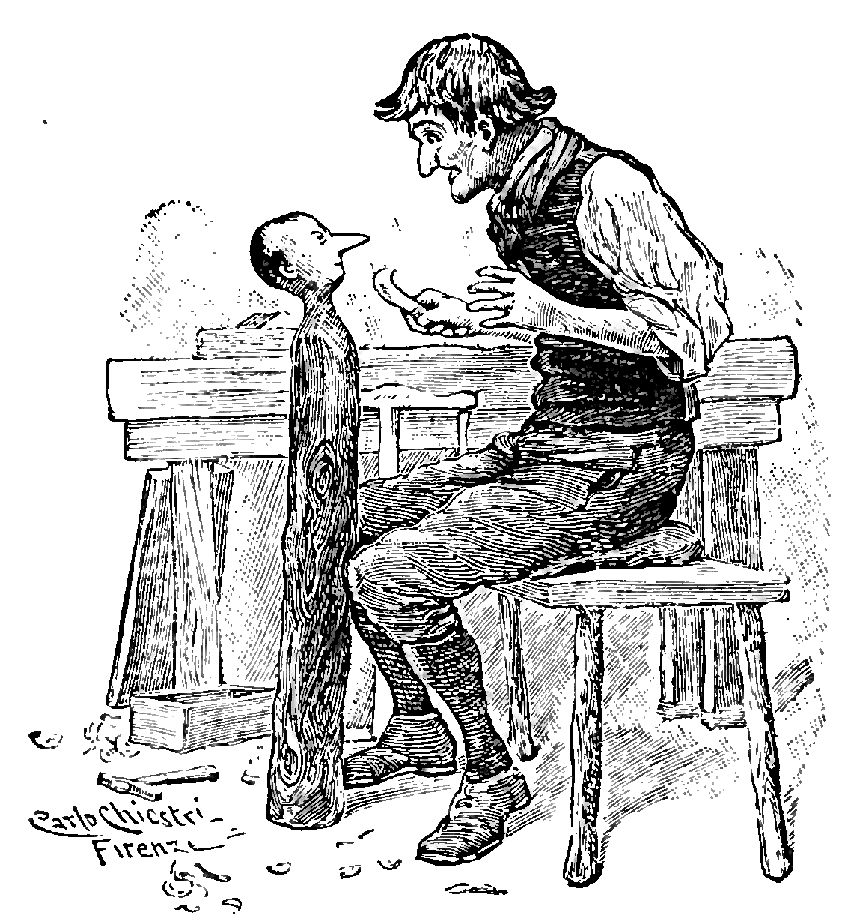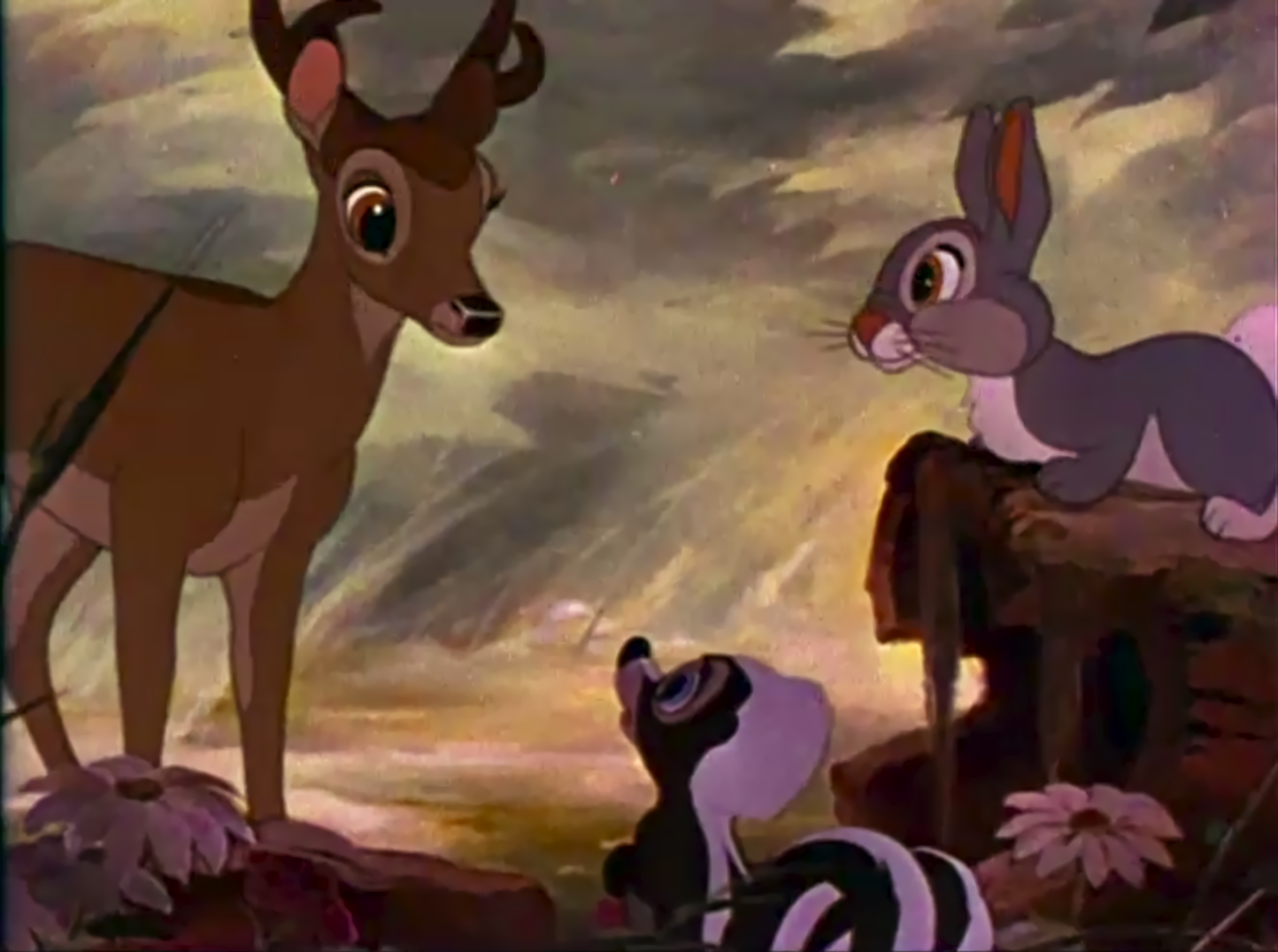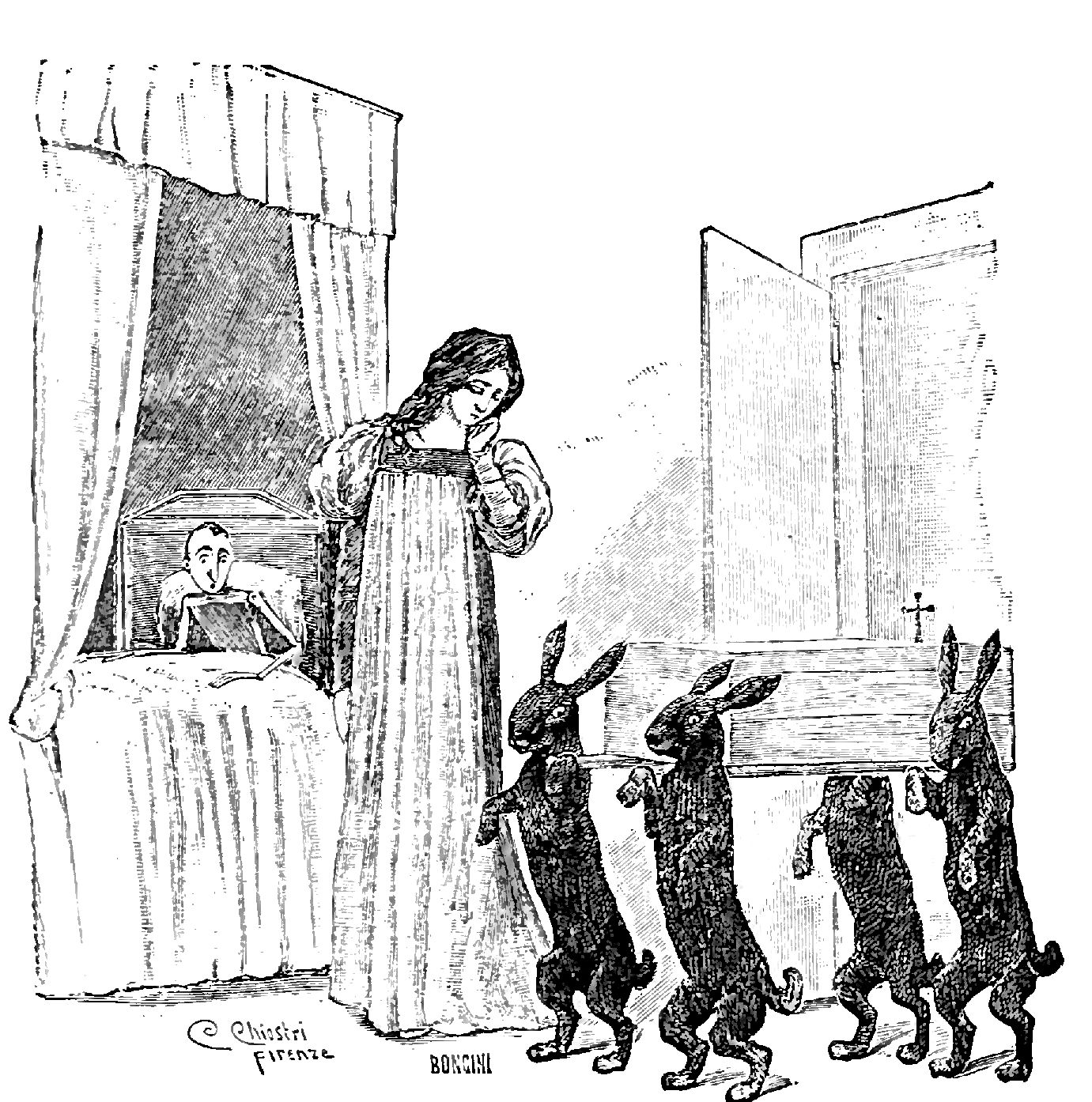|
Stromboli (Pinocchio)
Mangiafuoco ( ; , literally "Fire-Eater") is a fictional character who appears in Carlo Collodi's 1883 Italian book ''The Adventures of Pinocchio'' (''Le avventure di Pinocchio''), serving as a secondary antagonist turning good. Role He is the theatre director and puppet-master of the Great Marionette Theatre, portrayed as gruff and imposing, but capable of showing kindness and easily moved to compassion, which he expresses by sneezing: after initially wanting Pinocchio to be burned as firewood for ruining one of his puppet shows, he eventually sets him free and gives him five gold coins to give to his father Geppetto. In the novel Mangiafuoco is described as...a large man so ugly, he evoked fear by simply being looked at. He had a beard as black as a smudge of ink and so long that it fell from his chin down to the ground: enough so that when he walked, he stepped on it. His mouth was as wide as an oven, his eyes were like two red tinted lanterns with the light turned on at the ba ... [...More Info...] [...Related Items...] OR: [Wikipedia] [Google] [Baidu] |
The Adventures Of Pinocchio
''The Adventures of Pinocchio'' ( ; it, Le avventure di Pinocchio ; commonly shortened to ''Pinocchio'') is a children's fantasy novel by Italian author Carlo Collodi. It is about the mischievous adventures of an animated marionette named Pinocchio and his father, a poor woodcarver named Geppetto. It was originally published in a serial form as ''The Story of a Puppet'' ( it, La storia di un burattino) in the ''Giornale per i bambini'', one of the earliest Italian weekly magazines for children, starting from 7 July 1881. The story stopped after nearly 4 months and 8 episodes at Chapter 15, but by popular demand from readers, the episodes were resumed on 16 February 1882. In February 1883, the story was published in a single book. Since then, the spread of ''Pinocchio'' on the main markets for children's books of the time has been continuous and uninterrupted, and it was met with enthusiastic reviews worldwide. A universal icon and a metaphor of the human condition, the book is ... [...More Info...] [...Related Items...] OR: [Wikipedia] [Google] [Baidu] |
Walt Disney
Walter Elias Disney (; December 5, 1901December 15, 1966) was an American animator, film producer and entrepreneur. A pioneer of the American animation industry, he introduced several developments in the production of cartoons. As a film producer, he holds the record for most Academy Awards earned and nominations by an individual, having won 22 Oscars from 59 nominations. He was presented with two Golden Globe Special Achievement Awards and an Emmy Award, among other honors. Several of his films are included in the National Film Registry by the Library of Congress and have also been named as some of the List of films considered the best, greatest films ever by the American Film Institute. Disney was the first person to be nominated for Academy Awards in six different categories. Born in Chicago in 1901, Disney developed an early interest in drawing. He took art classes as a boy and got a job as a commercial illustrator at the age of 18. He moved to California in the early ... [...More Info...] [...Related Items...] OR: [Wikipedia] [Google] [Baidu] |
Wreck-It Ralph
''Wreck-It Ralph'' is a 2012 American computer-animated comedy film produced by Walt Disney Animation Studios and released by Walt Disney Pictures. The 52nd Disney animated feature film, it was directed by Rich Moore (in his feature directorial debut) and produced by Clark Spencer, from a screenplay written by Phil Johnston and Jennifer Lee, and a story by Moore, Johnston, and Jim Reardon. John Lasseter served as the film’s executive producer. Featuring the voices of John C. Reilly, Sarah Silverman, Jack McBrayer, and Jane Lynch, the film tells the story of the eponymous arcade game villain who rebels against his "bad-guy" role and dreams of becoming a hero. ''Wreck-It Ralph'' premiered at the El Capitan Theatre in Los Angeles on October 29, 2012, and went into general release on November 2. The film was a critical and commercial success, grossing $496 million worldwide against a $165 million budget and winning the Annie Award for Best Animated Feature, as well as receivi ... [...More Info...] [...Related Items...] OR: [Wikipedia] [Google] [Baidu] |
One Hundred And One Dalmatians
''One Hundred and One Dalmatians'' (also simply known as ''101 Dalmatians'') is a 1961 American animated adventure comedy film produced by Walt Disney Productions and based on the 1956 novel ''The Hundred and One Dalmatians'' by Dodie Smith. The 17th Disney animated feature film, it was directed by Hamilton Luske, Clyde Geronimi and Wolfgang Reitherman and written by Bill Peet, and features the voices of Rod Taylor, Cate Bauer, Betty Lou Gerson, Ben Wright, Lisa Davis, and Martha Wentworth. The film's plot follows a litter of Dalmatian puppies who are kidnapped by the villainous Cruella de Vil ("deVille"), who wants to make their fur into coats. Their parents, Pongo and Perdita, set out to save their puppies from Cruella, in the process of rescuing 84 additional ones that were bought in pet shops, bringing the total of Dalmatians to 101. The film was originally released in theaters on January 25, 1961, and was a box office success, pulling the studio out of the financial slu ... [...More Info...] [...Related Items...] OR: [Wikipedia] [Google] [Baidu] |
Cinderella (1950 Film)
''Cinderella'' is a 1950 American animated musical fantasy film produced by Walt Disney. Based on the fairy tale of the same name by Charles Perrault, it is the 12th Disney animated feature film. The film was directed by Wilfred Jackson, Hamilton Luske, and Clyde Geronimi. Mack David, Jerry Livingston, and Al Hoffman wrote the songs, which include "Cinderella", "A Dream Is a Wish Your Heart Makes", "Oh, Sing Sweet Nightingale", "The Work Song", "Bibbidi-Bobbidi-Boo", and " So This is Love". It features the voices of Ilene Woods, Eleanor Audley, Verna Felton, Rhoda Williams, James MacDonald, Luis van Rooten, Don Barclay, Mike Douglas, William Phipps, and Lucille Bliss. During the early 1940s, Walt Disney Productions had suffered financially after losing connections to the European film markets due to the outbreak of World War II. Because of this, the studio endured box office bombs such as ''Pinocchio'' (1940), ''Fantasia'' (1940), and ''Bambi'' (1942), all of which would la ... [...More Info...] [...Related Items...] OR: [Wikipedia] [Google] [Baidu] |
The Adventures Of Ichabod And Mr
''The'' () is a grammatical article in English, denoting persons or things already mentioned, under discussion, implied or otherwise presumed familiar to listeners, readers, or speakers. It is the definite article in English. ''The'' is the most frequently used word in the English language; studies and analyses of texts have found it to account for seven percent of all printed English-language words. It is derived from gendered articles in Old English which combined in Middle English and now has a single form used with pronouns of any gender. The word can be used with both singular and plural nouns, and with a noun that starts with any letter. This is different from many other languages, which have different forms of the definite article for different genders or numbers. Pronunciation In most dialects, "the" is pronounced as (with the voiced dental fricative followed by a schwa) when followed by a consonant sound, and as (homophone of pronoun ''thee'') when followed by a v ... [...More Info...] [...Related Items...] OR: [Wikipedia] [Google] [Baidu] |
Bambi (1942 Film)
''Bambi'' is a 1942 American animated drama film directed by David Hand (supervising a team of sequence directors), produced by Walt Disney and based on the 1923 book ''Bambi, a Life in the Woods'' by Austrian author and hunter Felix Salten. The film was released by RKO Radio Pictures on August 13, 1942, and is the fifth Disney animated feature film. The main characters are Bambi, a white-tailed deer; his parents (the Great Prince of the forest and his unnamed mother); his friends Thumper (a pink-nosed rabbit); and Flower (a skunk); and his childhood friend and future mate, Faline. In the original book, Bambi was a roe deer, a species native to Europe; but Disney decided to base the character on a mule deer from Arrowhead, California. Illustrator Maurice "Jake" Day convinced Disney that the mule deer had large "mule-like" ears and were more common to western North America; but that the white-tail deer was more recognized throughout America. The film received three Academy ... [...More Info...] [...Related Items...] OR: [Wikipedia] [Google] [Baidu] |
Jiminy Cricket
Jiminy Cricket is the Disney version of the "Talking Cricket" (Italian: ''Il Grillo Parlante''), a fictional character created by Italian writer Carlo Collodi for his 1883 children's book ''The Adventures of Pinocchio'', which Walt Disney adapted into the animated film ''Pinocchio'' in 1940. Originally an unnamed, minor character in Collodi's novel who is killed by Pinocchio before returning as a ghost, he was transformed for the Disney adaptation into a comical and wisecracking partner who accompanies Pinocchio on his adventures, having been appointed by the Blue Fairy (known in the book as the "Fairy with Turquoise Hair") to serve as Pinocchio's official conscience. In the film, he sings " When You Wish Upon a Star", the Walt Disney Company's signature song. Jiminy Cricket's appearance differs somewhat from that of actual crickets, which range from black to light brown and have long antennae and six legs; Jiminy Cricket has short antennae, a greenish-brown hue, and four limb ... [...More Info...] [...Related Items...] OR: [Wikipedia] [Google] [Baidu] |
The Fairy With Turquoise Hair
The Fairy with Turquoise Hair ( it, La Fata dai Capelli Turchini; often simply referred to as The Blue Fairy, ''La Fata Turchina'') is a fictional character in the 1883 Italian book ''The Adventures of Pinocchio'' by Carlo Collodi, repeatedly appearing at critical moments in Pinocchio's wanderings to admonish the little wooden puppet to avoid bad or risky behavior. Although the naïvely willful marionette initially resists her good advice, he later comes to follow her instruction. She in turn protects him, and later enables his assumption of human form, contrary to the prior wooden form. In the novel The Fairy with Turquoise Hair makes her first appearance in chapter XV, where she is portrayed as a young girl living in a house in the middle of a forest. Pinocchio, who is being chased by The Fox and the Cat (''Il Gatto e la Volpe''), pleads with the Fairy to allow him entrance. The Fairy cryptically responds that all inhabitants of the house, including herself, are dead, and that ... [...More Info...] [...Related Items...] OR: [Wikipedia] [Google] [Baidu] |
The Coachman
The Coachman ( it, Il Conduttore del Carro), also known as The Little Man (''L'Omino''), is a fictional character and a major antagonist who appears in Carlo Collodi's 1883 book ''The Adventures of Pinocchio'' (''Le avventure di Pinocchio''). In the novel The Coachman is introduced in chapter XXXI, and is described as thus:Picture for yourselves a little man, broader than he is tall, tender and greasy like a ball of butter, with a rosy face, a small, constantly laughing mouth and a thin, adorable voice of a cat wishing all the best to its master. The Coachman's name is never revealed, though he identifies himself in Chapter XXXI as merely "The Little Man" (''L’Omino''). He drives to the Island of Busy Bees (''Isola delle Api Industriose'') on a coach pulled by twenty-four donkeys which mysteriously wear white shoes on their hooves. By the time he arrives to take Pinocchio and Candlewick (''Lucignolo'') to the Land of Toys (''Il Paese dei Balocchi''), his carriage is completely ... [...More Info...] [...Related Items...] OR: [Wikipedia] [Google] [Baidu] |
Italians
, flag = , flag_caption = The national flag of Italy , population = , regions = Italy 55,551,000 , region1 = Brazil , pop1 = 25–33 million , ref1 = , region2 = Argentina , pop2 = 20–25 million , ref2 = , region3 = United States , pop3 = 17-20 million , ref3 = , region4 = France , pop4 = 1-5 million , ref4 = , region5 = Venezuela , pop5 = 1-5 million , ref5 = , region6 = Paraguay , pop6 = 2.5 million , region7 = Colombia , pop7 = 2 million , ref7 = , region8 = Canada , pop8 = 1.5 million , ref8 = , region9 = Australia , pop9 = 1.0 million , ref9 = , region10 = Uruguay , pop10 = 1.0 million , r ... [...More Info...] [...Related Items...] OR: [Wikipedia] [Google] [Baidu] |
Male
Male (symbol: ♂) is the sex of an organism that produces the gamete (sex cell) known as sperm, which fuses with the larger female gamete, or ovum, in the process of fertilization. A male organism cannot reproduce sexually without access to at least one ovum from a female, but some organisms can reproduce both sexually and asexually. Most male mammals, including male humans, have a Y chromosome, which codes for the production of larger amounts of testosterone to develop male reproductive organs. Not all species share a common sex-determination system. In most animals, including humans, sex is determined genetically; however, species such as ''Cymothoa exigua'' change sex depending on the number of females present in the vicinity. In humans, the word ''male'' can also be used to refer to gender in the social sense of gender role or gender identity. Overview The existence of separate sexes has evolved independently at different times and in different lineages, an example ... [...More Info...] [...Related Items...] OR: [Wikipedia] [Google] [Baidu] |





.png)


